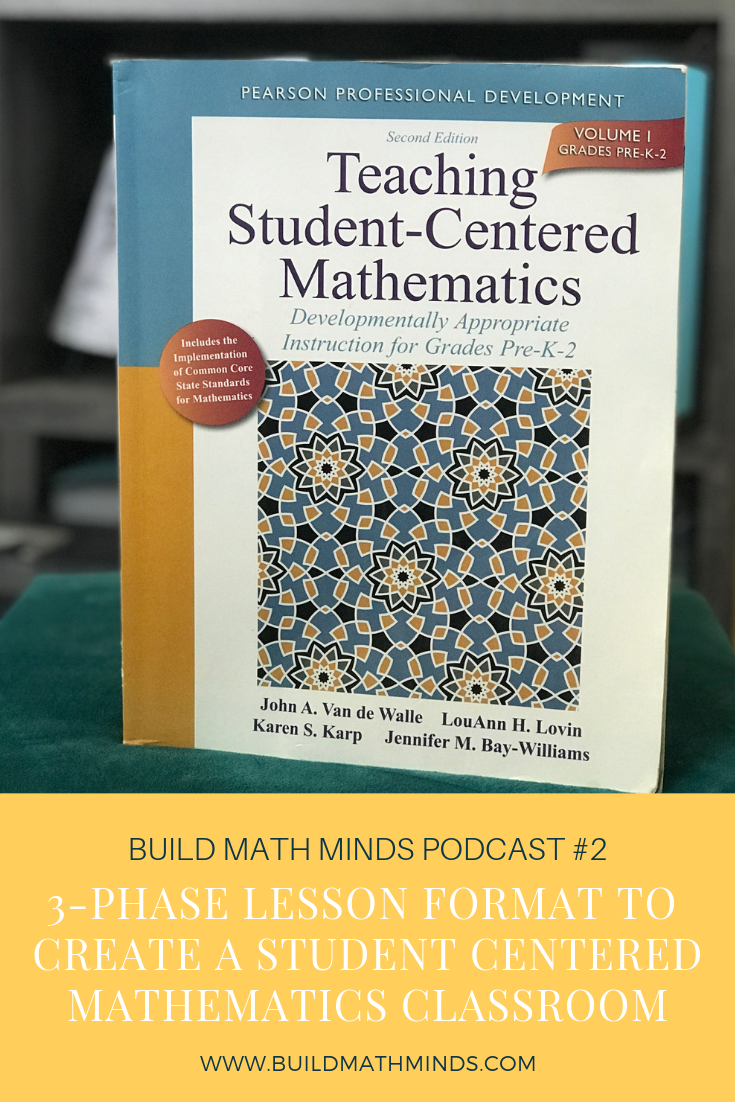Welcome fellow Recovering Traditionalists to Episode 2 where we will explore the 3-Phase Lesson Format that is essential to having a student-centered math classroom.
In Episode 1 I shared about Cognitively Guided Instruction. A big part of CGI is teaching math through story problems. Well as I started making that shift away from my textbook and to learning math through problem solving I found the book Teaching Student Centered Mathematics and it was a HUGE help. It quickly became my Math Bible. This is another book that I will likely do multiple episodes about but today is all about the 3-phase lesson format.
The Three-Phase Lesson Format is on pages 24-26 of the edition I have. I know there is a newer edition. Here is the insight from the book:
“A 3-phase lesson format (Before, During, After) provides a structure for teaching mathematics through problem solving. Before refers to the time before the children start work on the problem. During refers to the time during which the children work on the problem, and After refers to the discussion that takes place after children work on the problem.” p. 24
The next few pages go into detail about the phases but I’m going to highlight a big take-a-way that I had about each phase.
In the BEFORE phase it is very important to anticipate children’s strategies & their misconceptions. I honestly had never done that before. Even as I made my transition away from the textbook I was just picking problems and giving them to the students without even solving the problem myself sometimes!!! But in order to have a productive DURING and AFTER phase you have to take time exploring the problem yourself and anticipating the way that your students will explore the problem.
The DURING phase is when the kiddos are working on the problem. Now this is hard to admit but during that time I was usually off doing something else. Maybe preparing for the next thing we were doing. Instead the DURING phase should be a time that while the students are exploring the problem, you are exploring their thinking. This is prime time to be looking over shoulders to see what strategies they have and asking questions like “Why do you think that’s right?” “Can you tell me why you did _______?” and so on. These questions and you learning how they solved the problem leads into the AFTER phase.
The AFTER phase is honestly one of the most important. This is where you come together and share solutions and strategies. However, the one thing I didn’t do correctly was the sharing of strategies. I would have kids share but I never helped them make connections between strategies and that is an essential piece to the AFTER phase.
As I started moving away from just doing the next thing in my textbook, this 3-phase lesson format really helped me design my lessons. If you want to learn more about the 3-phase lesson and get some great ideas on activities to do in those lessons then I highly recommend you go get this book.
Subscribe and Review in iTunes
Hey, are you subscribed to the Build Math Minds Podcast, yet? If you’re not, make sure to do that today because I don’t want you to miss any episodes! Click here to subscribe to the podcast in iTunes.
While you’re there, don’t forget to leave a review on iTunes too. I would love to know your thoughts and how we can make sure that we give you content that you will really enjoy.
To leave a review, head over to iTunes and click on “Ratings and Reviews” and “Write a Review.” I can’t wait to hear your thoughts about the podcast.
Other Ways to Listen To This Episode
Pin This To Pinterest for Later





There’s an art to asking and receiving students’ questions. It’s the difference between making them feel like they’ve been put on the spot and making them feel like their input really matters.
The “why” questions remain my favorite. The more we practice this strategy the more we can engaging our students while building their math minds and critical thinking skills.
I agree. I love to ask “why” type questions and truly be interested in the answer without having an answer in mind that I’m expecting. It’s great to anticipate answers but sometimes I get comfortable and assume answers before I let kids fully flesh out their ideas.
Teaching Student Centered Mathematics has been my bible for instruction.
Mine, too!